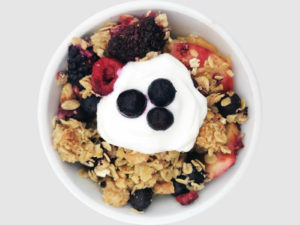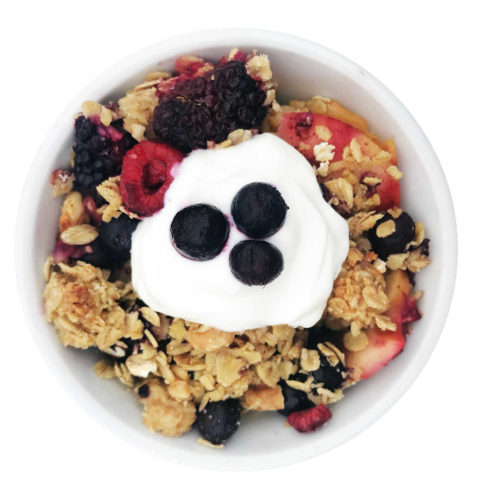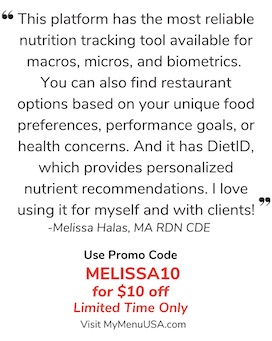
Starting your day with a brain-healthy breakfast is a great first step toward a healthy lifestyle. Here are 3 key tips to creating a brain food breakfast.
Did you know that one meal, in particular, has the greatest impact on your brain function throughout the day? Enter breakfast. Starting your day with a healthy breakfast is a great first step to better your brain health. Looking to do more for your brain? There are several other factors in your lifestyle that have a profound impact on your brain health.
Your brain health starts with the basics like sleep, a healthy, balanced diet, physical exercise, an active social life, and, depending on your diet, B vitamins, a multivitamin, or an omega-3 fatty acid supplement. This is something I evaluate when providing nutrition counseling to clients. It’s all about that TLC for your brain! But since breakfast often dictates your food choices for the rest of the day, it’s important to get it right with brain-stimulating breakfast foods. Feel confident about your brain-supporting choices by following these three tips to better your health, energy, and focus.
3 Tips for a Brain Food Breakfast
- Choose healthy fats (including ones with omega-3 fatty acids)
- Include B vitamins
- Choose whole grains
Keep reading for the reasons why these are brain-healthy nutrients and how to maximize your selections.
1. Choose Healthy Fats and Include Some with Omega-3 Fatty Acids
Pump the brakes on digestion speed to reap the benefits of long-lasting energy. In the right amounts, adding healthy fats to your breakfast, like the omega-3 fatty acids in walnuts and olive oil, can help stabilize blood sugar levels to prevent unwanted sugar crashes!
Adios sweet cravings; there is a new satiated sheriff in town! Plus, feeling satisfied helps prevent you from reaching for something sweet or low in nutrients.
Walnuts also contain alpha-linolenic acid, a type of omega-3 fatty acid essential for brain health. This is why they’re a great choice as part of your brain food breakfast. Olive oil contains polyphenols that offer neuroprotective effects. (1)
2. Include B Vitamins
“B” is for breakfast (and brain), but it’s also the type of vitamins that adults miss out on when they skip their morning meals. Include mighty B vitamins to promote brain health.
Plus, breakfast skippers tend to fall victim to the later in the day snack attacks—often resulting in more added sugars and excess calories. (2)
3. Go Whole Grain or Go Home!
Whole grains provide feel-full fiber—a key nutrient that helps slow down digestion, ultimately contributing to satiety and longer-lasting energy. Plus, research shows that dietary intake of whole grains is associated with better cognitive function. (3) Do more for your brain by experimenting with whole grains like oats, buckwheat, amaranth, millet, polenta, sorghum, etc.
Brain Food Breakfast – Very Berry Breakfast Apple Pie
Make breakfast a no-brainer with this delicious pie. It’s a tasty whole-grain breakfast that’s powered by oats. Since this hearty ingredient goes through minimal processing, they hardly ever lose their germ or bran—no matter what type of oat you buy (regular, quick, instant, or steel-cut oats).
So, opt for whatever oat floats your boat! But stay clear of flavored instant oatmeal since it tends to contain high amounts of unwanted added sugar and salt.
This recipe can satisfy your sweet cravings by providing a boost of healthy nutrients. Plus, it makes getting in those five servings of fruits and vegetables a day a piece of cake…or rather, pie! Serve over a cup of your favorite nonfat Greek yogurt to boost the protein.

Very Berry Breakfast Apple Pie

Rate this Recipe!
Ingredients
Fruit Mix
- 2 medium apples (Fuji, Honeycrisp, or Pink Lady)
- 2 cups frozen mixed berries (like blueberry, raspberry, and blackberry)
- 2 tsp cinnamon
- 2 tsp honey
- 1/4 cup walnuts
- 1 cup granola or homemade oat topping (see separate instructions) or store bought granola
- 1 tbsp plain nonfat Greek yogurt
- 1 tsp olive oil
Homemade Oat Topping
- 3/4 cup whole oats
- 1/4 cup whole-wheat flour (use oat flourfor gluten-free substitution)
- 3 tbsp olive oil
- 1.5 tbsp honey
Instructions
- Preheat the oven to 350°F and lightly grease a pie dish with olive oil.
- Thinly slice the apples with a mandolin or a knife.
- Coat appleslices with honey and cinnamon.
- In alternating layers, place the sliced apples and mixed berries in your pie dish.
- If you opted for the Homemade Crumbled Honey Oats topping, combine all oat toppingingredients in a medium bowl and mix well, then add this to the top of your pie. (If using pre-made granola, add this to the top after baking the pie.)
- Bake for35-45 minutes, or until apples are tender.
- Removefrom the oven and let cool.
- Put yourserving in a bowl, then top with a dollop of Greek yogurt and/or whipped creamand enjoy this tasty morning treat!
Nutrition
References
- Vauzour, David. “Dietary Polyphenols as Modulators of Brain Functions: Biological Actions and Molecular Mechanisms Underpinning Their Beneficial Effects.” Oxidative Medicine and Cellular Longevity, vol. 2012, 2012, pp. 1–16., https://doi.org/10.1155/2012/914273
- 2. S. Fanelli, C. Walls, C. Taylor. Skipping breakfast is associated with nutrient gaps and poorer diet quality among adults in the United States. Proceedings of the Nutrition Society, 2021; 80 (OCE1) DOI: 10.1017/S0029665121000495
- Samieri, Cécilia, et al. “Mediterranean Diet and Cognitive Function in Older Age.” Epidemiology, vol. 24, no. 4, 2013, pp. 490–499., https://doi.org/10.1097/ede.0b013e318294a065.



